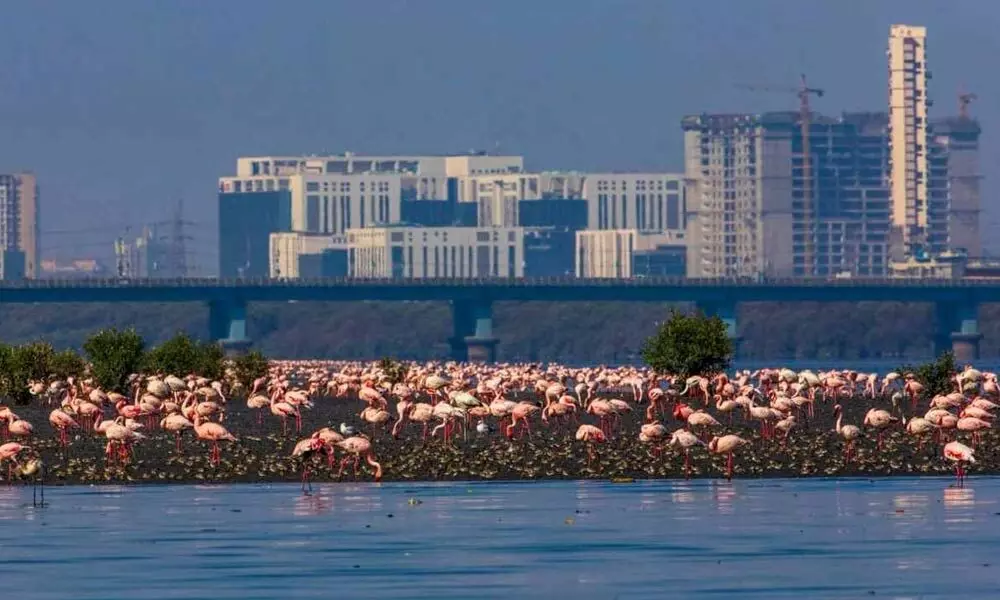Channelling the power of youth

Channelling the power of youth
A 2019 report by New Jersey-based Climate Central predicted that two major Indian coastal cities – Mumbai and Kolkata – will drown by 2050, as a result of climate change-linked sea level rise
A 2019 report by New Jersey-based Climate Central predicted that two major Indian coastal cities – Mumbai and Kolkata – will drown by 2050, as a result of climate change-linked sea level rise. Green spaces and the natural beauty woven into the city's magic is under threat. In case you have any doubts, here's a fact: we're among the last generations that can save the city from preventable, climate-induced damnation.
With the city's narrow geography and growing population, space has become a commodity 'more valuable than gold'. Mumbai's often-ignored floodplains – its wetlands, mangroves and salt pans – are a critical role in the city's defence and resilience to flooding. Studies have shown that half the city could experience regular flooding by 2050, and green cover in and around the city is important to mitigate these impacts.
Steady upticks in vehicular and industrial activity over recent decades have also culminated in an air pollution problem that won't go away. Simultaneously, the twin troubles of limited land and rapid expansion has put the biodiversity of Mumbai at serious risk. As per a recently published study in peer-reviewed journal Nature, Mumbai has lost around 42.5 percent of its green cover in the last three decades alone. Despite local communities and the scientific community emphasizing the importance of building climate resilience in a timely manner, the local biodiversity has been left out of the priority list of the local government.
Unsustainable development in the city has shrunk and divvied up natural green spaces and destroyed habitats for important species in the region. This, without making these regions inviting for the local biodiversity. The mangroves that drape the massive coastline function both as buffers against flooding and as carbon sinks (an important component in the natural carbon cycling). Mangroves are four times as effective as forests in trapping atmospheric carbon, making them more important than ever before in Mumbai's resilience to climate change. And yes, instead of cultivating mangroves, they are being destroyed rapidly to make more way for more reclaimed land, construction, and waste disposal facilities.
Although the government claims reforestation and protected zones are being created in the region's Master Plan, it is important to remember that many of these ecosystems are not replaceable. Even the Bombay High Court ruled that the destruction of mangroves "offends the fundamental rights of citizens."
2019 saw an overwhelming response – both from citizens and the government – to thousands of trees in the Aarey Forest being cut down to make way for a car shed and depot. It demonstrated a widening gap between the interests of citizens and the local government in environment and climate policy. It also presented an opportunity to create a larger climate movement in Mumbai.
There is a large population of young Mumbaikars who either grew up in, or moved to, the city. They have participated in visible socially-conscious conversation. They aren't afraid to speak their minds, or mobilize for causes they identify with. Now, with Mumbai's biodiversity under threat, and the city at a critical juncture, will its youth mobilize for a sustainable, climate-resilient future? Mumbai, too, could become an example to the world in championing sustainable urban planning. The Ministry of Mumbai's Magic (MMM) was born as a catalyst to help the city's people see that vision as possible.
It is a collective of youth focused on digital and local solutions, using the creative and social might to protect what makes Mumbai magical. The citizens leading this movement believe that the collective power of this generation can cause unprecedented change for good, beyond what any government can do alone. The youth are taking back ownership, and taking on the responsibility of being the change that Mumbai needs. They are looking to make it the city they believe they deserve to live in.
The MMM collective aims to create a climate movement of young Mumbaikars, who are interested in an inclusive and active climate debate – to safeguard Mumbai's future, but also their own. The aim is to develop a strong voice that influences sustainable policymaking and environment-conscious leaders in India.
Biodiversity by the Bay is MMM's pilot campaign, to build a new movement of young Mumbaikars to champion the protection of the city's biodiversity and its inhabitants. Through this campaign, the youth and subject matter experts have come together to invoke government action towards preserving the city's vibrant biodiversity. The campaign will culminate by sharing the recommendations of Mumbaikars with Aaditya Thackeray, the State Minister for Environment and Tourism, who has shown an interest in engaging in conversations about building climate resilience and preserving the ecosystem.
The appeal includes a five-point action plan including the protection of Lesser Flamingos and their habitats, given their significance to Mumbai; increasing the protection for Mumbai's green cover; proposing a supportive policy for the Koli community's livelihoods, in consultation with the community; and protecting and growing Mumbai's parks.
For a generation that's grown up in the age of innovation, the thought behind this platform is to present a space to spark new ideas and share innovative solutions led by Mumbai's youth. It is aspirational and nostalgic. Collectively, we aim to push the boundaries and fight for climate action in Mumbai. The name and identity is a result of what we thought would resonate with the people of Mumbai.
(This article was first published at http://www.firstpost.com. Reprinted with their permission)

